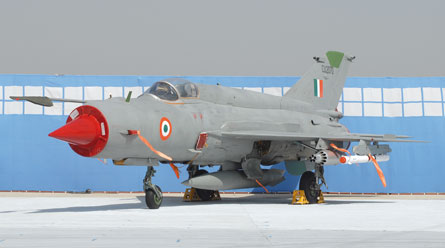The six manufacturers bidding for India's largest fighter tender have submitted their responses to its request for proposals, but defence analysts believe the competition has a long way to go before reaching a resolution.
India's defence ministry, which had extended its deadline for the submissions by a month, says it received responses ranging between 7,000 and 20,000 pages each by its 28 April deadline. "We will now examine all the bids and issue a shortlist of two or three before making a final decision," it says. The 126-aircraft requirement is expected to be worth more than $12 billion, while an option will be held for another 64.
Hindustan Aeronautics will licence-produce 108 of the selected aircraft over 10 years, as part of an offset package worth at least 50% of the deal's total value. The new fleet is need to replace India's RSK MiG-21 fighters (below).
 |
|---|
© Peter Foster |
Boeing is touting the F/A-18E/F Super Hornet's low maintenance costs, and its partnership with Indian companies such as HAL, Larsen & Toubro and Tata Industries. "If the F/A-18IN is selected, these companies and others are expected to play a significant role as Boeing transfers some production and assembly to India," it says.
Dassault is offering its Rafale, while EADS, representing the European consortium that manufactures the Eurofighter Typhoon, says: "As part of our industrial co-operation offer, we invite India to become a member of the successful Eurofighter family. India is our partner of choice and we are interested in long-lasting political, industrial and military relations."
Lockheed Martin, which successfully concluded the sale of six C-130J tactical transports to India during February, says its F-16IN will be specifically tailored to meet the country's needs. "We have spent years assessing the needs of the Indian air force, and we believe it will not just meet but exceed Indian expectations."
Russia's hopes are pinned on the MiG-35, while Saab's Gripen IN will have a lifetime logistics support solution sourced from Indian suppliers, with the backing of the Swedish manufacturer and its partners. "The Gripen IN will provide India with a capability that offers complete independence of weapon supply. We will do this by transferring all necessary technologies to enable Indian industry and the air force to build, operate and modify Gripen to meet all indigenous requirements over time," the company says.
The Indian air force plans to evaluate the bids over the next few months and begin field trials by early 2009. Commercial bids will be opened after negotiations, and New Delhi has said that it wants the aircraft to be in service around 2012.
However, one Indian analyst familiar with the procurement process says this is probably wishful thinking. "It will take more than a year, and probably two, to study all the submissions and conduct field tests. After the shortlist is issued, more tests and discussions will take place and that should last at least a year," says the source. "Price negotiations will take at least half a year, and that is being optimistic. Delivery will take at least two to three years after the contract is signed. Given that, I don't expect the fighter to be in service until 2014 at the earliest."
Source: Flight International



















